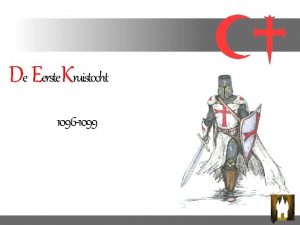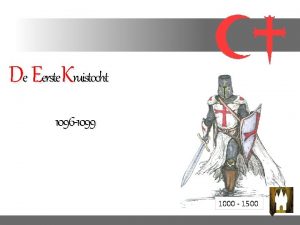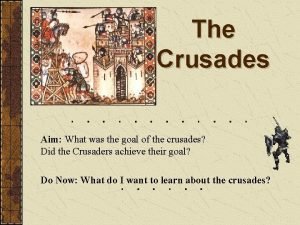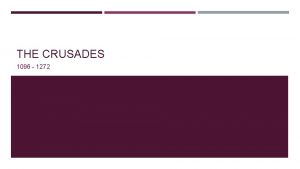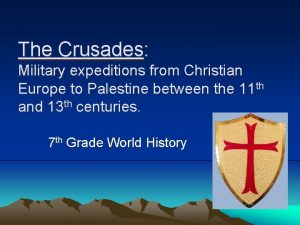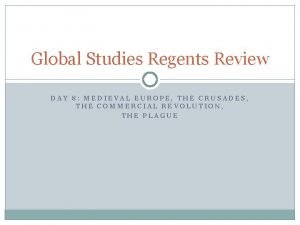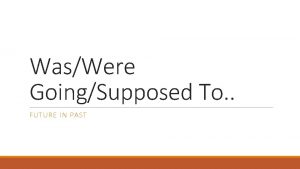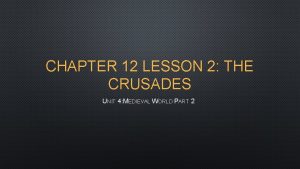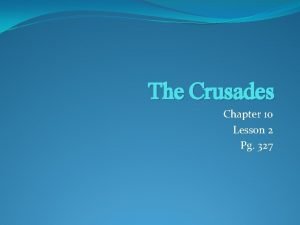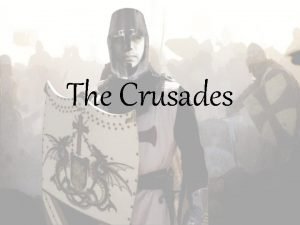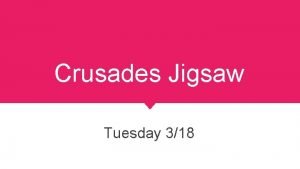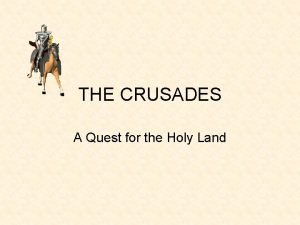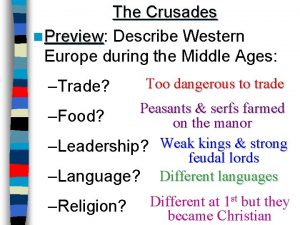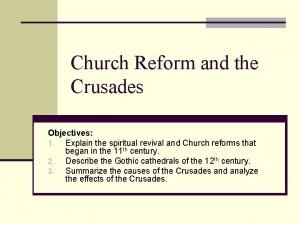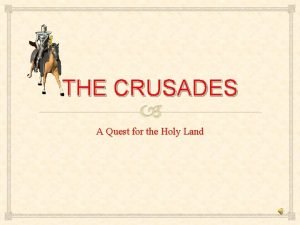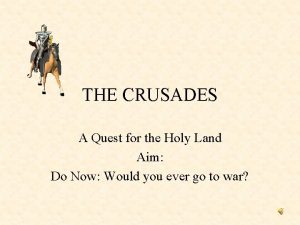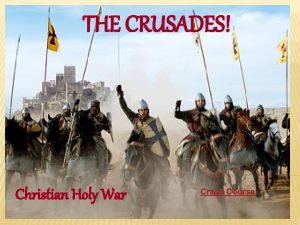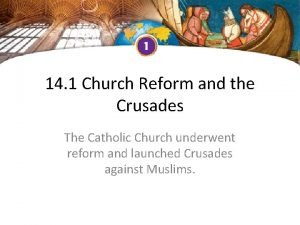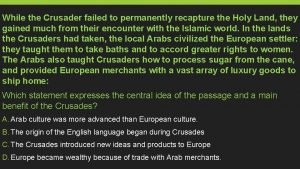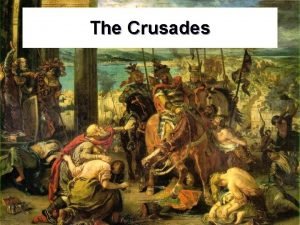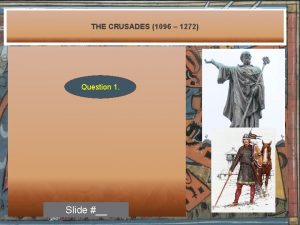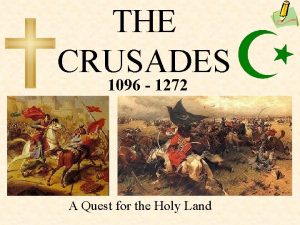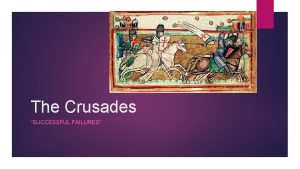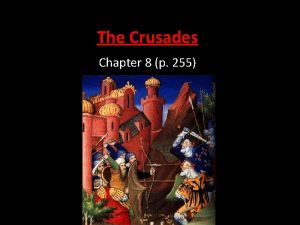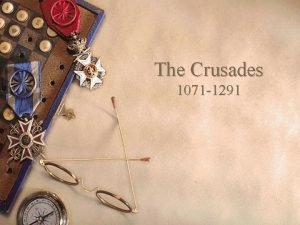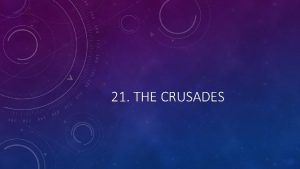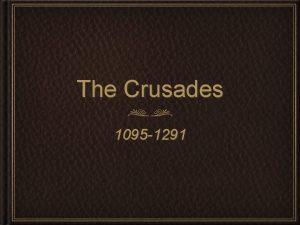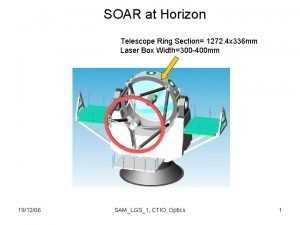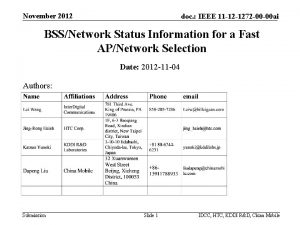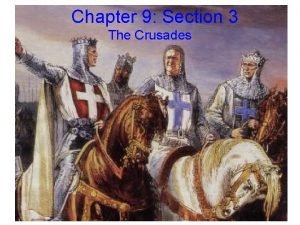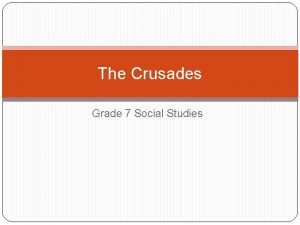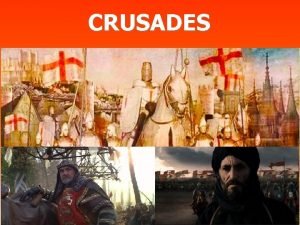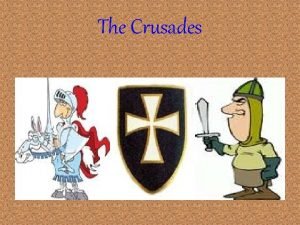THE CRUSADES 1096 1272 WHAT WERE THE CRUSADES
























- Slides: 24

THE CRUSADES 1096 - 1272

WHAT WERE THE CRUSADES? Between the 11 th and 13 th century, European Christians carried out a series of military expeditions to regain the Holy Land from the Muslims.


WHY DID THE CRUSADES START? Byzantine Emperor Alexius I asked Pope Urban II for help against the Seljuk Turks after the defeat of the Byzantine army at Manzikert in the year 1071.

WHO WERE THE SELJUK TURKS? Muslims who had taken control of Asia Minor.

WHY DID POPE URBAN II AGREE TO HELP? Helping afforded him the opportunity to provide leadership for a great cause.

WHAT GREAT CAUSE? To free Jerusalem and the Holy Land from infidels, or unbelievers – the Muslims.

ADDITIONAL CAUSES OF THE CRUSADES

HOW WAS THE 1 ST CRUSADE ORGANIZED? Council of Claremont Held in Southern France Late 1095 Pope Urban II challenged Christians to take up their weapons and join in a holy war. He promised the men who did so: “All who die… shall have immediate remission [forgiveness] of sins. ” The crowds response: “It is the will of God, it is the will of God. ”

WHO MADE UP THE INITIAL CRUSADING ARMIES? WHAT MOTIVATED THEM? Warriors from Western Europe Mostly from France They were motivated by: Religious fervor Adventure seeking Opportunity to gain wealth Trade: Italian merchants sought new markets in Byzantine and Muslim lands.

FIRST CRUSADE (1096 – 1099) Three bands (mostly French) made their way east. Thousands of men, mostly cavalry and infantry. 1098 - They captured Antioch 1099 (June) – They reached Jerusalem. They avoided the well defended coastal cities of the Palestine coast. The Holy City (Jerusalem) was taken amid a massacre of its inhabitants. After further conquests: Crusaders organized four Latin states in the east. These crusader kingdoms depended on Italian port cities, merchants to be specific, for supplies. The Italian port cities included Genoa, Pisa, and Venice. These port cities great rich and powerful.

SECOND CRUSADE (1147 – 1149) 1140 s – Muslim armies began to strike back. Bernard of Clairvaux, monastic leader, enlists King Louis VII of France and Emperor Conrad IV of Germany. 1187 – Jerusalem falls to Saladin and his Muslim forces. This crusade was a total failure.

WHO IS SALADIN? Sultan of Egypt He had taken control from the Fatimid Dynasty and formed the Ayyubid Dynasty Led Muslim armies during the 2 nd and 3 rd Crusades

THIRD CRUSADE (1189 – 1192) Began as a reaction to the recapturing of Jerusalem by Muslim forces. 1189 – Three leaders went with their armies: Emperor Frederick Barbarossa of Germany King Richard I of England (aka Richard the Lionhearted) King Phillip II Augustus of France Troubles: Frederick drowned in a local river French and English forces arrived by sea and captured coastal cities, but were unable to move inland. Phillip returned to France. Richard I negotiated a settlement with Saladin, which permitted Christian pilgrims free access to Jerusalem.

FOURTH CRUSADE (1201 – 1204) 1193 – Saladin dies 1199 – Pope Innocent III initiates a new crusade. On the way east the armies become involved in a fight over the Byzantine throne. Venetian leaders used this opportunity to weaken their greatest commercial competitor. 1204 – Crusaders sacked Constantinople. 1261 – Byzantine army recaptures the city.

CHILDREN’S CRUSADE (1212) 1212 – German youth, Nicholas of Cologne, was inspired to lead a “children’s crusade”. Thousands of German youths marched to Italy and the Pope told them to go home. Around the same time: French youth, Stephen de Cloyes, and 20, 000 French children headed to Marseille (port city in the South of France) Ship owners agreed to take them to the Holy Land Two ships went down and five arrived in N. Africa, where the children were sold into slavery.

FIFTH CRUSADE (1218 – 1221) 1213 – Pope Innocent III calls for a 5 th crusade 1215 – The Church divides Europe into taxation sections and imposes new taxes to support the call to arms in. 1217 – The crusading armies are ready to head out. Led by King Andrew II of Hungary, Duke Leopold VI of Austria, and John of Brienne Before the armies even arrive in the Holy Land, al-Kamul , Saladin’s nephew, offers to give the crusaders the Holy Land, no questions asked. The Pope decides he wants to hold out for all of Egypt. The Pope expects Holy Roman Emperor Frederick II to arrive with an additional army to force al-Kamul to give up all of Egypt Frederick II never arrives 1221 – Crusaders are led by Roman cardinal Pelagius into Egypt Unbeknownst to Pelagius and the crusaders, they camp on a flood plain of the Nile River Muslim army opens the barriers and the crusaders are no more. This crusade is a failure.

SIXTH CRUSADE (1228 – 1229) Frederick II actually went to the Holy Land though not as the Pope expected He adopts eastern and Arab habits This understanding of the language and culture leads Frederick II to help al-Kamul with a family conflict Leads army to Jerusalem but there is no need for bloodshed since the family conflict has been dealt with While in Jerusalem, he negotiates an agreement, which returns the Holy Land to Christians Part of the agreement allows Muslims to still worship there. Christians, in return, would provide military aid to Muslim armies when they faced the Mongol hordes. The Pope is still angry with Frederick II not showing up during the 5 th Crusade and excommunicates him. The consequence: any Christian that goes to Jerusalem (Holy Land) will be excommunicated as well. *If this seems counterintuitive, it is*

SEVENTH CRUSADE (1248 – 1254) 1248 – The Pope announces a new crusade. In a new twist, this crusade is against Frederick II (Holy Roman Emperor). The crusade is led by Louis IX of France. Mamluk army (Muslims) had retaken Jerusalem and it was no longer safe for Christians. Louis IX’s army is struck with dysentery, an intestinal illness. 1254 - He retreats. This crusade is a failure.

EIGHTH CRUSADE (1270) Led by Louis IX of France Meant to go aid crusaders in Syria but the ships go to Tunis, Tunisia Louis IX dies shortly after arriving in Tunis Battle of Tunis is a failure Remaining army returns to Europe

NINTH CRUSADE (1271 – 1272) Led by Prince Edward (later Edward I of England) Sails to Acre Mamluk army is unstoppable This crusade is a failure This last crusade demonstrates the lack of ‘crusader spirit’ left in Europe.

WHAT WERE SOME OF THE EFFECTS OF THE CRUSADES? Italian port cities (Genoa, Pisa, and Venice) increased trade with the East. Historians disagree whether or not this was an effect of the Crusades or something that would have occurred without the military expeditions. The beginning of widespread persecution of Jews in Europe Pogroms in Eastern Europe/Russia Expulsion from different European countries i. e. Spain, England Political: Break down of feudalism. Creation of stronger, centralized governments The system of government in medieval Europe. Kings at the center of power Growth of wealth Taxation of trade with the East Portugal, Spain, England, and France emerged as powerful nations. Mamluks emerge as powerful group in Egypt and bring about end of crusader states in the Middle East

SOURCES It is highly advise that you supplement the information in this PPT with the additional sources. They will provide additional information that is needed to complete your recruitment poster. https: //worldhistoryproject. org/topics/the-crusades/page/1 These are summarized explanations of each crusade, as well as each battle. Feel free to use Wikipedia as well since it does provide accurate information regarding the cities were the crusading armies left from and the cities they went to. Remember though – this does not mean Wikipedia is an appropriate source when completing research for an essay that requires real sources. http: //westernreservepublicmedia. org/middleages/crusades. htm The Eighth Crusade includes information for the Nineth Crusade and the aftermath in the region http: //www. historytoday. com/interactive/key-moments-crusades-interactive-map http: //www. datesandevents. org/events-timelines/22 -the-crusades-timeline. htm Timeline of the Crusades – lists the leaders of each crusade.

GUIDELINES FOR CRUSADES RECRUITMENT POSTER The poster should be no smaller than 11 x 14. I don’t think you’ll need to make something the size of a science poster board but I will leave that to your discretion. Poster must include: Name of Crusade Year(s) of Crusade Motivating cause – Why should possible recruits join? Leaders recruiting/leading the crusade A map showing where you are starting from and where you are going Battles that occur during this crusade Any important figures or groups that come about during this crusade Slogan – Be creative! A slogan is a great way to get possible recruits excited about the cause. Short essay – 1 page Explain in a well thought out essay: What caused this particular crusade? What are the consequences of this particular crusade? Presentation: Be prepared to explain your poster and summarize your essay. Use your presentation to give the audience a complete understanding of your poster and of your particular crusade. Take pride in all the work you’ve put in and make it a stellar presentation.
 Kruistocht 1096
Kruistocht 1096 1096 ad
1096 ad Kruistocht 1096
Kruistocht 1096 What were the goals of the crusades
What were the goals of the crusades Were the crusades successful
Were the crusades successful The crusades were military expeditions undertaken by
The crusades were military expeditions undertaken by What were two indirect results of the crusades
What were two indirect results of the crusades The crusades were military expeditions undertaken by
The crusades were military expeditions undertaken by Future in past
Future in past Chapter 12 lesson 2 world history
Chapter 12 lesson 2 world history Lesson 2 the crusades
Lesson 2 the crusades What is a crusade
What is a crusade The crusades a jigsaw activity answer key
The crusades a jigsaw activity answer key Crusades recruitment poster project
Crusades recruitment poster project Crusades through arab eyes
Crusades through arab eyes How did the crusades change europe
How did the crusades change europe Church reform and the crusades
Church reform and the crusades Crusades recruitment poster ideas
Crusades recruitment poster ideas Crusader recruitment poster
Crusader recruitment poster Crusades
Crusades Crash course crusades
Crash course crusades Chapter 14 section 1 church reform and the crusades
Chapter 14 section 1 church reform and the crusades Crusades webquest
Crusades webquest Crusades used in a sentence
Crusades used in a sentence đại từ thay thế
đại từ thay thế
